In recent time, diverse voices in comics appears to be gaining much deserved critical attention. This is in large part due to the numerous prolific and talented artists making these exciting books. Created by Jiba Molei Anderson and published by Chicago’s Griot Enterprises, The Horsemen offers a futuristic African-American narrative through merging the superhero genre with a thoughtful (and action-packed) investigation utilizing the spirit of African deities. This week The COMP magazine caught up with Anderson to discuss his early artistic influences, his professional efforts with Griot Enterprises, his process in creating this flagship book, his role as an educator, and his upcoming projects and comics conventions set for 2018.
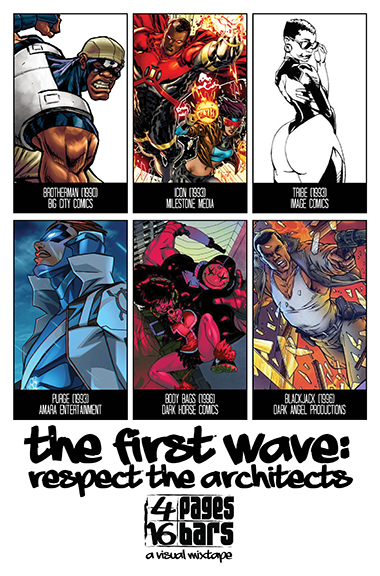
“The First Wave: Respect the Architects” 4 Pages 16 Bars: A Visual Mixtape promotional poster • 14.5” X 22” • Adobe InDesign • 2018
Lets start with some background. You are originally from Detroit and landed in Chicago for university studies, and have since been creating at Griot Enterprises with Jude W. Mire and La Morris Richmond. Are there any early experiences that you see as informing your present aesthetic practice? Are there any individuals you see as inspiring current efforts?
Griot Enterprises was created in 1997. Kenjji Jummane-Marshall, Michael C. Larson and myself were initial principles of the company.
We were inspired by the growth of the comic book industry independent of Marvel Entertainment and DC Entertainment. We were especially inspired by the emergence of the independent Black Comix movement, which was spearheaded by Big City Comics’ Brotherman, Milestone Media, which was distributed by DC Comics and Todd Johnson and Larry Stroman’s Tribe, published by Image Comics.
Being a company created by three artists, we challenged each other to create better work, as we were our own inspiration. Diverse creators such as George Perez, Jose Luis Garcia-Lopez, Matt Wagner, John Byrne, Jason Pearson, Adam Hughes, Brian Stefreeze also inspired our individual aesthetics.
Currently, there are so many creators, African-American creators in particular, whose work I respect and admire. The Black Comix community is so diverse aesthetically it’s truly amazing. To single one or two creators would be doing a disservice to so many others.
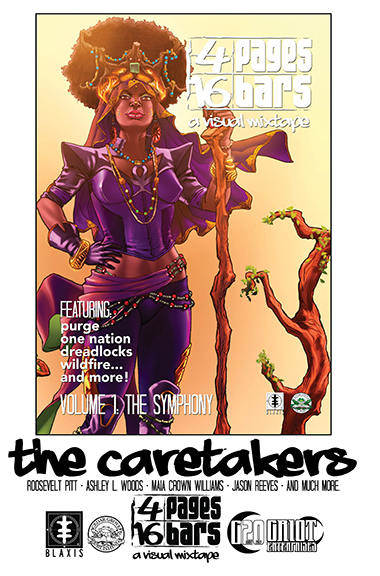
“The Caretakers” 4 Pages 16 Bars: A Visual Mixtape promotional poster • 14.5” X 22” • Adobe InDesign • 2018
Griot Enterprises is a multi-faceted venture with a focus upon presenting diverse voices in comics. Specifically, the content centers upon minority characters not widely seen in the mainstream. In recent time this issue has been marginally addressed in a handful of publications (e.g., Ms. Marvel, Black Panther, Saga). How do you hope to advance and expand upon these voices and therefore make their position more visible? What do you hope to ultimately convey to your readers?
Griot is somewhat evangelical when it comes to promoting not only our brand and our properties but also the Black Comix movement as a whole.
4 Pages 16 Bars: A Visual Mixtape is a 4-volume (and counting) anthology series I created to celebrate and promote the diverse voices from the Black Comix movement. I was inspired by working with creator / academics like John Jennings and Damian Duffy who spearheaded these types of collaborations. In order for my properties to gain more attention, the movement itself needs to be promoted. There is strength in numbers.
With my property, The Horsemen, my goal was to create an American mythology free from the influence of Judeo-Christian, Eurocentric faith systems. I used the faith systems of the Yoruba as the basis of my superheroic myth. I wanted to create a saga of African and African-American super beings that would be appealing to any audience without negating any aspect of my culture in order to do so.
The Horsemen is a celebration of all cultures through a Pan-African lens. I want my readers to feel represented through my work even as they may not be the same culture, gender, nationality, etc.
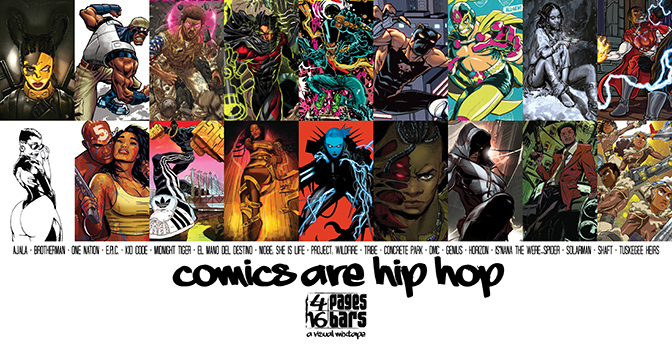
“Comics Are Hip Hop” 4 Pages 16 Bars: A Visual Mixtape promotional poster • 33” X 17” • Adobe InDesign • 2017
Can you walk us through your project, “The Horsemen: Divine Intervention”? On one level you are utilizing material found in ancient African myth while simultaneously working with traditional superhero tropes. What make “Horsemen” unique?
I was born in 1972. My parents were newly graduated from college, smack dab in the middle of that cultural awakening. Indeed, my mother is from Liberia and my father is from the States. My birth was Pan-African in nature. I grew up in an environment where it was the U.S. outside my window and Africa behind closed doors. I grew up with the traditions, the food, the politics, the music, the art, the strength and power of African culture, the endurance, tenacity, passion, creativity and drive of African-American culture. “Black is Beautiful” was more than a slogan growing up, it was and is a way of life.
Following the Pan-African mindset and my dual cultural nature, The Horsemen reflects my worldview. I wanted to show a very modern Africa, I was extremely tired of the “famine and underdeveloped” narrative that the continent is saddled with in this country. I also wanted to address the problems that Post-Colonialism left behind on the continent as well.
I wanted the world of The Horsemen to feel real, free from the mythology of Afrocentrism and its adherence to Egyptology. I wanted to work with a different African faith system, a system that when The Horsemen was created (in 1997), no one, I mean NO ONE, was thinking of. No one was thinking of using the Orishas as a launch point for a comic book world at that time. I wanted to focus more so on the Western part of the continent where my family, and the majority of African-Americans hail from.
I’ve always been a fan of alternate dimensions and, mythology is great tool in exploring that concept. Unlike the Marvel Universe, which treats the gods of myth as aliens from other planets, I prefer to think of mythological beings as realized potential if certain roads were traveled as opposed to others. In the broadest of strokes, you could link my work to Jonathan Hickman (East of West) or Rick Reminder (Black Science) even though The Horsemen precede both of those titles by a good number of years.
The Horsemen was Afrofuturism before the term was coined.
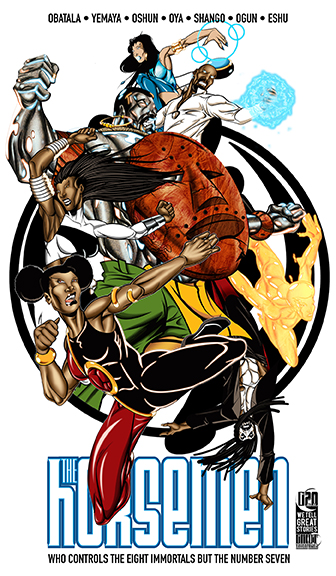
The Horsemen • 14” X 22” • Blue Pencil & Digital • 2018
What do you value most in your aesthetic practice?
Good question.
When I was a younger artist, I used to value growth and technique. You know, the things that many young artists are concerned about. However, through trying to master the fundamentals, I feel that I’ve lost a bit of that innocent creative spark. That innocence allowed for more experimentation. I want to capture that innocence again, if only for a moment.
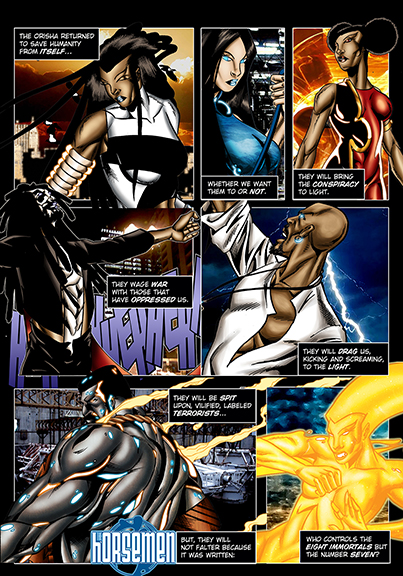
The Horsemen from Mythos: The Official Handbook of the Horsemen Universe • 7” X 10” • Pen, Ink and Digital • 2017
How do you see the content and materials you create reflecting the time in which you live?
I feel that the materials are immaterial to the work that’s being created. By that I mean the materials used are just an extension of the creator’s vision.
Now, with that pretentious bit of pseudo-esoteric philosophy said, I’ve been in a slow transition, kicking and screaming, to a fully digital process. It’s neither quicker nor easier than working with the “analog” materials of pen, paper and paint. It allows for last-minutes edits to be made. It makes it somewhat easier to appease a client’s wishes. But, I do miss mastering the classic materials of illustration. I hope to get to a level of relative comfort so that I can “play” again.
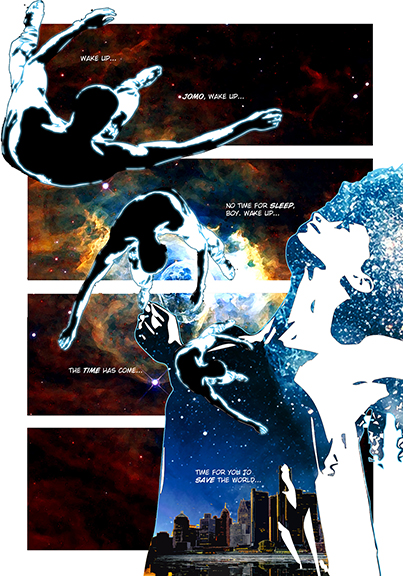
Jomo’s Resurrection from Mythos: The Official Handbook of the Horsemen Universe • 7” X 10” • Pen, Ink and Digital • 2017
You teach animation, multimedia practice and video game design at Chicago State University. As an educator, what do you hope to inspire in your students? Are there any specific ideas or items you consistently hope to share with your students?
I actually taught animation and video game design at the Illinois Institute of Art – Schaumburg for 11 years. I’ve been at Chicago State University since 2014 teaching multimedia.
I’ve found that I’ve been most inspirational in teaching my students an independent spirit and a confidence in their abilities. Many of my students have worked for DC and Marvel Comics and the video game & animation industries. Many have them have gone into education carrying the philosophies I’ve espoused forward.
That’s pretty profound when you think about it.
In my role as an educator, I teach the importance of craft and passion manifested in one’s presence and presentation. I stress the importance of studying the history of went before and the history that’s happening right now to inform what will be created in the future. I teach my students how to imagine not only what they will create, but how to navigate careers in this crazy game I call The Art Life. And, as much as I hope to teach, I also learn from the ones I’m educating. They are the future and it always helps to think ahead.
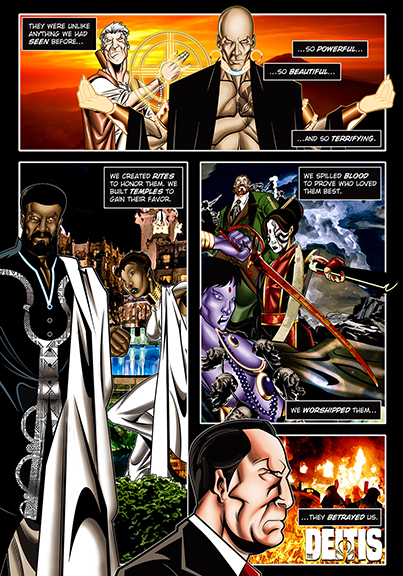
The Deitis from Mythos: The Official Handbook of the Horsemen Universe •
7” X 10” • Blue Pencil and Digital • 2017
What’s the plan for the new year? What projects do you have currently in process? Any goals or new materials in process for the next 12 months?
Right now, I’m finishing the third issue of Mythos: The Official Handbook of the Horsemen Universe. This series is a great introduction to what I like to call The New Mythology; the concept is which the Horsemen reside. The book reads like oral tradition, as if I am the traveling storyteller going from community to community telling the tales of gods and goddesses as parables for living a different life.
I’m also contemplating a fifth volume of the 4 Pages 16 Bars: A Visual Mixtape anthology. Getting the first four volumes was a feat, but the project has generated a great deal of interest…
And, there are a number of artists that I couldn’t get the first time that I’m sure I can have involved with another volume.
We’re also currently running a GoFundMe campaign to raise $60,000.00 to keep Griot Enterprises going for the next year. Our goal is to attend at least eight conventions throughout 2018 to meet old fans, make new fans, and sell some books.
Griot Enterprises has been around for 20 years and we’re just getting started!
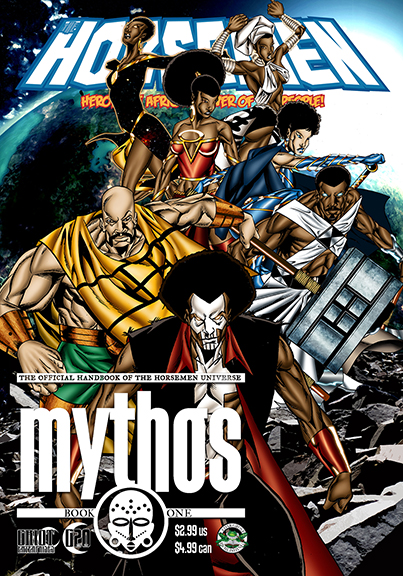
The Horsemen from Mythos: The Official Handbook of the Horsemen Universe • 7” X 10” • Pen, Ink and Digital • 2017
For additional information on Jiba Molei Anderson and Griot Enterprises, please visit:
Griot Enterprises – https://www.griotenterprises.com/
Go Fund Me Griot Enterprises – https://www.gofundme.com/GriotEnterprises
Jiba Molei Anderson on Twitter – https://twitter.com/jazintellect?ref_src=twsrc%5Egoogle%7Ctwcamp%5Eserp%7Ctwgr%5Eauthor
Afropunk – http://afropunk.com/2015/02/feature-jiba-molei-anderson-birth-of-the-new-mythology/
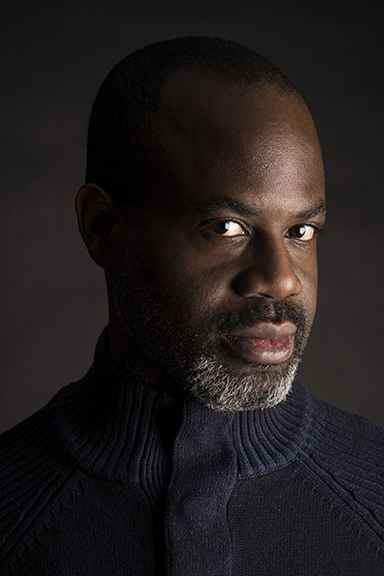
Jiba Molei Anderson, 2017
Artist interview by Chester Alamo-Costello


